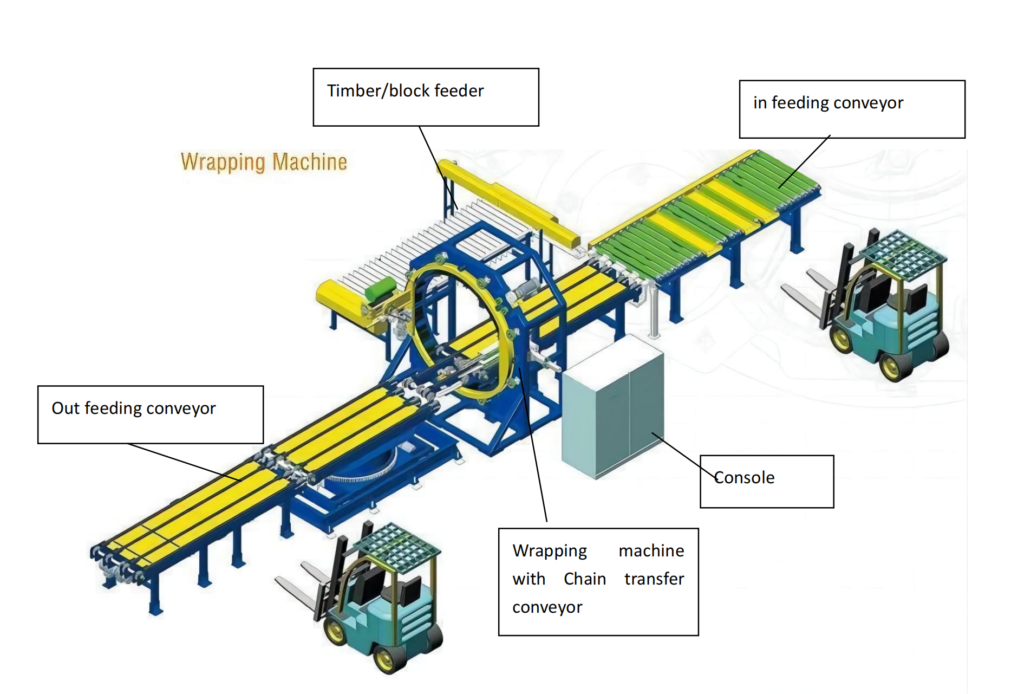Mastering Long Product Protection: A Guide to Semi-Automatic Orbital Stretch Wrappers
Handling and packaging long, bulky, or irregularly shaped items like pipes, extrusions, lumber, or tubing presents unique challenges in manufacturing and distribution. Traditional pallet wrapping methods often fall short. The semi-automatic orbital stretch wrapper emerges as a specialized, efficient solution designed specifically for these applications, ensuring product integrity from the production line to the final destination.
This guide explores the operation, benefits, and key applications of semi-automatic orbital stretch wrappers, providing insights aligned with the practical, instructional focus valued in the fabrication industry.
Visual demonstration of a semi-automatic orbital stretch wrapper in operation.
What Defines a Semi-Automatic Orbital Stretch Wrapper?
Unlike turntable wrappers where the load rotates on a platform, a semiauto orbital stretch wrapper keeps the product stationary (typically supported by conveyors). The core component is a vertical rotating ring carrying the stretch film roll. This ring moves orbitally around the length of the product as it passes through the machine's wrapping zone.
The "semi-automatic" aspect means an operator typically initiates the process: positioning the product, starting the wrap cycle, and sometimes manually cutting the film or securing the tail (though many models feature automated clamping and cutting). This approach balances automation efficiency with flexibility for varying product lengths and operator oversight.
Operational Workflow: Step-by-Step
While specific controls vary by manufacturer, the typical operation follows these steps:
- Loading: The operator places the elongated product (or bundle) onto the infeed conveyor, guiding it towards the wrapping ring.
- Securing (if needed): Depending on the product, initial securing might be necessary.
- Initiating the Cycle: The operator starts the wrapping cycle via the control panel (often a user-friendly touch screen). Pre-set parameters like ring speed, conveyor speed, film tension, and overlap are activated.
- Orbital Wrapping: The ring rotates around the product while the film roll dispenses stretch film. Simultaneously, the conveyor moves the product longitudinally through the ring, creating a spiral wrap along its entire length. The machine precisely controls film overlap and tension for a secure, protective layer.
- Cutting and Sealing: Upon cycle completion (often detected by sensors or based on programmed length), the machine automatically clamps and cuts the stretch film. Some systems include heat sealing for the film tail.
- Unloading: The fully wrapped product exits onto the outfeed conveyor, ready for transport or storage.

bubble film orbital stretch wrapper Key Technical Specifications
Understanding the typical parameters helps in assessing machine capability. Note that the specifications below are indicative and may not precisely match the equipment shown in the video. For exact machine specifications tailored to your needs, direct consultation is recommended.
- Machine Type: Semi-Automatic Orbital Stretch Wrapper
- Primary Application: Wrapping long, narrow, or irregular-shaped products
- Wrapping Material: Compatible with standard stretch film and pre-stretched film
- Maximum Product Length: Typically unlimited (depends on conveyor setup)
- Maximum Product Cross-Section (Width/Height): Example: up to 500mm x 500mm (varies significantly by model)
- Ring Rotation Speed: Adjustable, e.g., 100-200 rpm
- Conveyor Speed: Adjustable, e.g., up to 15 m/min
- Power Requirements: Common standard: 230V, 50Hz, single phase (confirm based on region/model)
- Approximate Machine Dimensions: Length: 3500mm; Width: 1500mm; Height: 1800mm (footprint varies)
- Approximate Machine Weight: Around 800kg
- Control System: PLC (Programmable Logic Controller) with HMI (Human-Machine Interface), often a touch screen
- Safety Features: Emergency stop buttons, physical guarding, safety interlocks
- Film Management: Semi-automated or automated film clamp, cut, and wipe/seal system

orbital stretch wrapper for panel 6 sides wrapping (2) Advantages of Orbital Wrapping for Elongated Items
Employing a semi-automatic orbital wrapper offers distinct advantages:
- Enhanced Product Protection: Provides a tight, conforming wrap that shields products from dust, moisture, scratches, and surface damage during handling and shipping.
- Improved Load Stability: Securely bundles loose items (like pipes or rods) or wraps single long pieces, preventing shifting and potential damage.
- Operational Efficiency: Significantly faster and more consistent than manual wrapping methods for long products. Reduces labor requirements.
- Material Savings: Optimized film tension control and consistent overlap can lead to more efficient stretch film usage compared to manual application.
- Versatility: Effectively handles a wide range of product shapes and lengths that are difficult or impossible to wrap on standard pallet wrappers.
Diverse Industrial Applications
The utility of semi-automatic orbital stretch wrappers spans numerous sectors:
Metal Extrusions and Profiles
Aluminum, steel, or plastic extrusions are often long and susceptible to surface damage. Orbital wrapping provides crucial protection, maintaining aesthetic quality and preventing costly scratches or corrosion, especially for finished or coated profiles.
Piping, Tubing, and Conduits
Manufacturers of metal or plastic pipes, tubes, and electrical conduits use these machines to bundle products securely. This prevents items from separating during transit and protects ends from impact damage, ensuring product integrity for construction or industrial use.
Woodworking and Millwork
Items like dimensional lumber, trim, molding, dowels, and flooring planks benefit greatly from orbital wrapping. It protects against moisture absorption, warping, dirt, and handling damage, preserving the quality of the wood products for builders and end-users.
Other Applications
The technology is also applicable to textiles (rolls of fabric), bundles of reinforcing bar (rebar), plastic profiles, and other elongated materials requiring secure unitization and protection. For broader packaging insights, resources from organizations like PMMI (The Association for Packaging and Processing Technologies) can offer valuable context.

Conclusion
For operations dealing with the logistical challenges of long or irregularly shaped products, the semi-automatic orbital stretch wrapper offers a robust and efficient packaging solution. By providing consistent, protective wrapping tailored to elongated items, these machines help ensure product quality, enhance load security, and streamline packaging workflows across diverse industries like metal fabrication, construction supply, and woodworking. Understanding their operation and benefits is key to optimizing packaging processes for these specialized product types.
